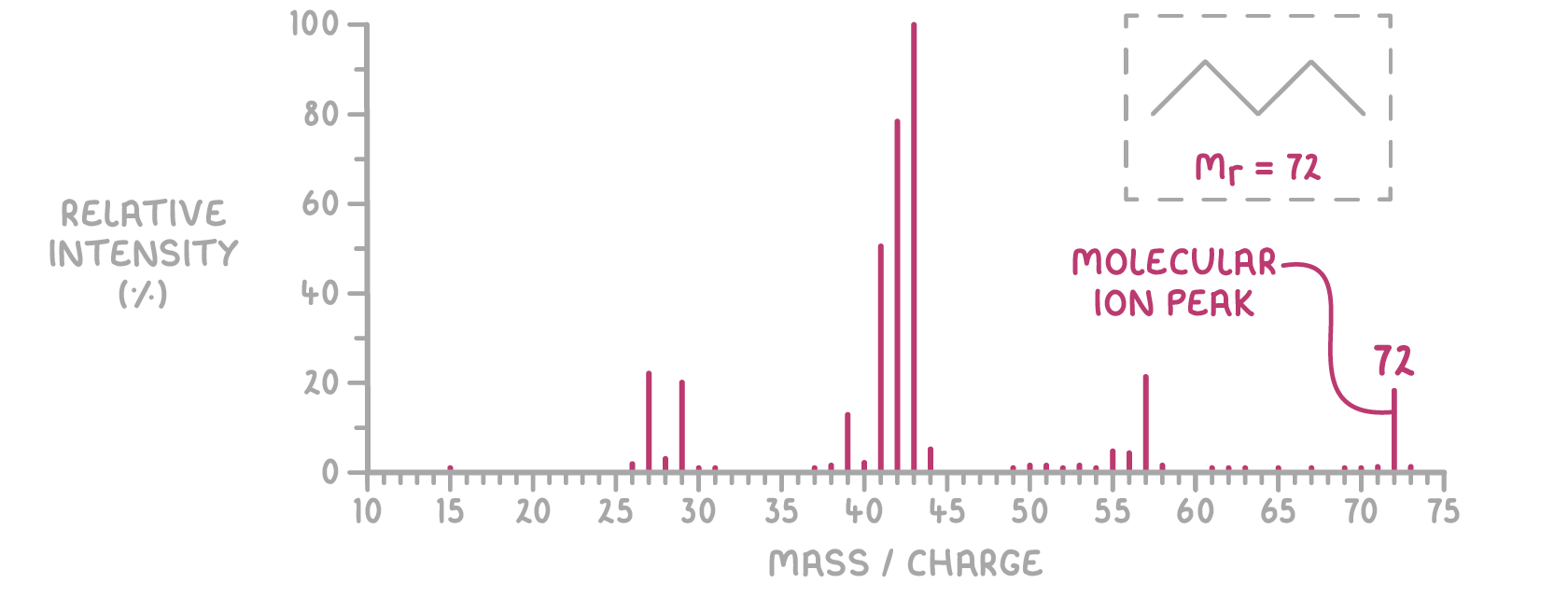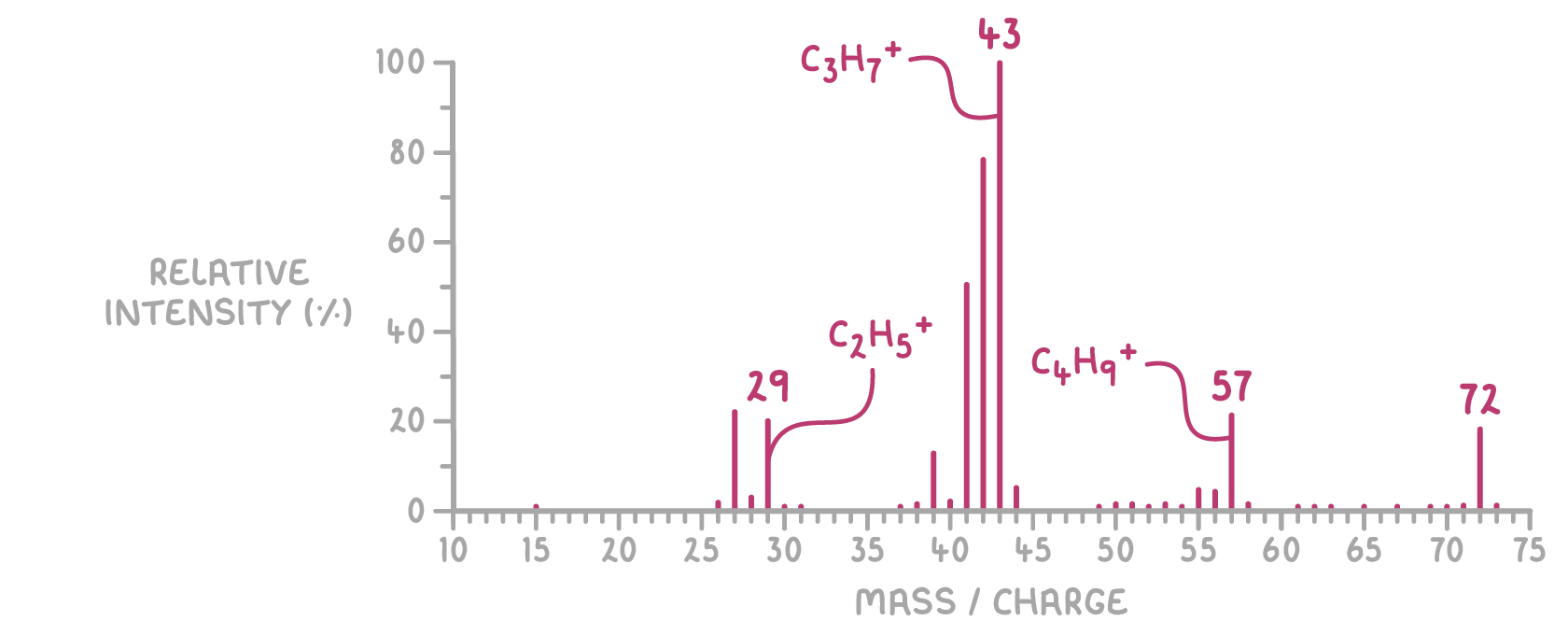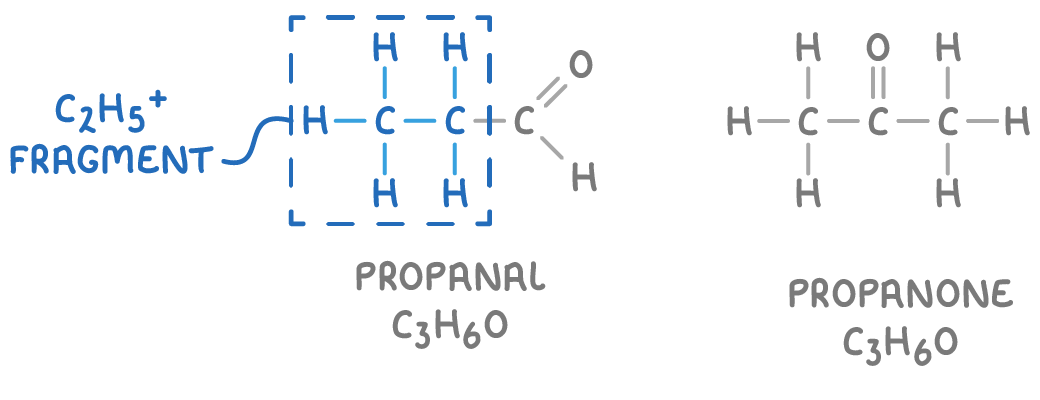Mass Spectrometry
This lesson covers:
- How mass spectrometry works to produce mass spectra
- Using molecular ion and fragmentation peaks to determine molecular mass and structure
- Using M+1 and M+2 peaks
- Differentiating compounds using fragmentation patterns
Mass spectrometers produce mass spectra
Mass spectrometry involves bombarding vaporised sample molecules with electrons, resulting in the production of charged fragments. These fragments are then separated based on their mass-to-charge ratio (m/z) and detected to create a mass spectrum.
Here are the key steps:
- The sample is vaporised, turning it into a gas.
- An electron beam bombards the gaseous molecules, knocking out an electron to form molecular ions (M+).
- Some of these molecular ions break apart into smaller fragment ions.
- The ions are then deflected through a magnetic field, which separates them according to their mass/charge ratio (m/z).
- Finally, the separated ions are detected and their data is displayed as a mass spectrum.
A mass spectrum represents the abundance of each fragment against its m/z value, providing critical information about the sample's composition.
Molecular ion (M) peak indicates molecular mass
The molecular ion peak, or M peak, in a mass spectrum indicates the relative abundance of the intact M+ ions. Assuming the molecular ion carries a +1 charge, the m/z value of this peak directly corresponds to the compound's molecular mass. Thus, the m/z value of the M peak reveals the compound's relative molecular mass (Mr).
For instance, in the mass spectrum below, pentane (C5H12) has an M peak at m/z 72. This shows that pentane's relative molecular mass is 72 g mol-1.

Using M+1 peak to calculate number of carbons (n)
The relative size of the [M+1] peak can be used to determine the number of carbon atoms (n) in an unknown organic compound.
The [M+1] peak is caused by molecules containing a 13C isotope atom instead of the more common 12C isotope. As carbon has a 1.1% natural abundance of 13C, the percentage [M+1] peak abundance relates to the number of carbon atoms.
The equation is:
n =1.1100×abundance of M+ ionabundance of [M+1]+ ion
Worked example 1 - Calculating the number of carbons using the M+1 peak
An unknown compound has an M peak with a relative abundance of 97.6% and an [M+1] peak with an abundance of 2.4%.
Calculate the number of carbon atoms in the molecule.
Step 1: Equation
n =1.1100×abundance of M+ ionabundance of [M+1]+ ion
Step 2: Substitution and correct evaluation
n =1.1100×97.62.4=2.24
As the number of carbon atoms must be an integer, the compound likely contains 2 carbon atoms.
The M+2 peak indicates the presence of chlorine or bromine
The presence and identity of halogen atoms in an organic compound can be determined by examining the [M+2] peak.
An [M+2] peak is caused by molecules containing a 37Cl or 81Br isotope atom instead of the more common 35Cl or 79Br isotopes.
- If the [M+2] peak height equals the M peak height, there is one bromine atom per molecule.
- If the [M+2] peak is one-third of the height of the M peak, there is one chlorine atom per molecule.
This occurs because:
- Bromine has an equal abundance of 79Br and 81Br isotopes.
- Chlorine has isotopes of 35Cl (75%) and 37Cl (25%).
So the relative [M+2] peak height reveals whether Br or Cl is present.
For example:
- Bromomethane (CH3Br) will have a molecular ion peak at m/z = 94 corresponding to [CH379Br]+ and an M+2 peak of equal intensity at m/z = 96 corresponding to [CH381Br]+.
- Chloromethane (CH3Cl) will have a molecular ion peak at m/z = 50 corresponding to [CH335Cl]+ and an M+2 peak at one third of the intensity at m/z = 52 corresponding to [CH337Cl]+.
Fragmentation produces pattern related to structure
When molecular ions break apart, they form fragment ions that appear as distinct peaks on the mass spectrum.
These fragments can include:
- CH3+ (m/z = 15)
- C2H5+ (m/z = 29)
- C3H7+ (m/z = 43)
- OH+ (m/z = 17)
The pattern of fragmentation offers clues about the molecule's structure, as the m/z values of these peaks can be matched to known fragments to deduce the structural formula.
For example, the mass spectrum of pentane shows:

- A peak at m/z 29 suggests the presence of a CH3CH2+ fragment, indicating an ethyl group within the molecule.
- A peak at m/z 43 suggests a CH3(CH2)2+ fragment, indicating a propyl group.
- A peak at m/z 57 suggests a CH3(CH2)3+ fragment, indicating a butyl group.
Mass spectra differentiate between compounds
Compounds with identical molecular formulas can have unique fragmentation patterns in their mass spectra. This uniqueness enables mass spectrometry to distinguish between closely related molecules, such as propanal and propane, despite them having the same formula, C3H8O.

Propanal, for instance, can fragment to produce a C2H5+ ion, a fragmentation that is not possible for propane.
Computer databases can rapidly match an unknown compound's distinctive spectrum to identify its structure.